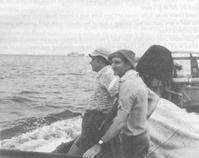


Radio Technical Officers
Foreword
Acknowledgements
Preface
Introduction
Chapter 1: The Early Years
Chapter 2: The Training School
Chapter 3: Equipment Installation Records
Chapter 4: The 'Techs' in Antarctica
Chapter 5: The 'Techs' Tell Their Stories
Trevor Donald Tells It All; Life in the Bureau from 1947 to 1989
Ray Clarke Looks Back
Some Memories from Ralph Bulloch
Peter Copland Works in Meteorological Electronics
Some Titbits from Dave Grainger
A Very Modest Tale from Alf Svensson
Adrian Porter Pulls No Punches
Jack Tait Recalls
Some Stories by Colourful Freddie Soutter
Some Snippets from Noel Barrett
Stephen CourbÍt Has His Penny Wworth
And a Flyspeck or Two from Lenny Dawson
Some Interesting Reminiscences from Jannes Keuken
Brief Stories from Phil Black
From Gloria West, Wife of the Late Bob West
The Life and Bureau Times of Graham Linnett
Tales Out of School from Bill Hite
Peter Copland on Cyclone Tracy
Peter Broughton Tells the Story of Maralinga
Appendix 1: 'Techs' Roll Call
Appendix 2: Trainee Intakes
Appendix 3: 'Techs' Who Have Served in the Antarctic Region
Appendix 4: Summary of Major Installation Projects
Appendix 5: Summary of Major Equipment Variously Installed at Sites and Maintained by Radio Technical Officers
Index
Search
Help
Contact us

Some Stories by Colourful Freddie Soutter (continued)
After servicing North East Island AWS we headed for Melville Bay, an ex-Catalina flying boat base, now the port for shipping bauxite from Nhulunbuy (Gove), Gove being an ex-RAAF WWII air base. I had spent about twelve months at 321 Radar Outpost not far from Gove so it was great to see some of that area thirty years later, and to see those red pebbles we used to curse as we walked around barefooted; they were always hot. Little did we know at the time that they were almost pure bauxite, the base for the manufacture of aluminium. With my ever keen interest in nature I wondered at the fact that after thirty years the eucalypts had not grown any higher than I remembered them during my WWII stay in the area.After a minor crew change the Cape Morton headed for Wessel Island and the AWS there which had been off the air for a long period of time. The first up inspection showed that the nicad batteries had completely failed and taken the Carbonair Y cells with them. Fortunately we had a good supply of new Y cells but how to overcome the problem of the main 24 volt supply posed a problem; enter Tim, the LARC driver. Tim said that he had hidden on the ship two 12 volt marine batteries as an emergency for the LARC and offered them if Captain Chesterman was agreeable. A radio conference with him was favourable on the proviso that I sent a cable to the Bureau's Regional Director, Ray Wilkie, in Darwin requesting him to have replacements available for the Cape Morton upon our arrival there. It was a major effort to get the AWS on air in a short time since, due to the tide change, we had to weigh anchor at about 4 pm and sail to Cape Don Lighthouse for the replenishment of stores there plus the conduct of maintenance by the ship's staff.

The hand hewn stone light tower at Cape Don was a magnificent piece of architecture. The lightkeeper had a few queries and having a digital barometer with me I gave the observational equipment a check over.
The lightkeeper said that they had had a number of problems with water buffalo around the area and to be wary of them. As I had to wait for the provisioning and servicing of the light, given my ever love of wandering the scrub, I headed off along the track back to where the LARC comes ashore hoping to get photographs along the beach. As I rounded a bend in the track I encountered a small herd of buffalo. I froze. Then after these animals had given me the once over they quietly sauntered off into the scrub, much to my delight and thanks.
Our next call was to Cape Forecroy AWS. We encountered few if any problems other than a faulty intrusion alarm sensor.
 |
Bureau of Meteorology |  |
© Online Edition Australian Science and Technology Heritage Centre and Bureau of Meteorology 2001
Published by Australian Science and Technology Heritage Centre, using the Web Academic Resource Publisher
http://www.austehc.unimelb.edu.au/fam/1245.html